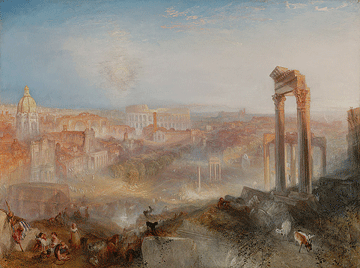Extraordinarily inventive and enduringly influential, the great British artist J. M. W. Turner (1775–1851) produced many of his most important and famous pictures after the age of sixty, in the last fifteen years of his life. A dazzling new show at the Getty Center demonstrates the ongoing radicalism of his technique and ever-original subject matter, bringing together over sixty key oil paintings and watercolors, making this major international loan exhibition is the first to focus on the unfettered creativity of Turner’s final years.

Despite his fame, wealth and ailing health, Turner was never content to rest on his reputation. He continued to travel extensively, depicted novel subject matter, experimented with different canvas formats, and pioneered free and spontaneous techniques in both oil and watercolor. He developed new ways of rendering atmospheric and coloristic effects to convey the awesome and emotive powers of the elements, pushing the boundaries of expression in any media he used.
Yet even as he experimented with form and technique, Turner maintained a firm commitment to narrative and meaning in his compositions. Paintings that at first sight appear to solely illustrate effects of light and color frequently provide opportunities for contemplation on humanity’s role in history and place in the natural world. To reinforce such themes Turner often accompanied his paintings with lines of poetry including some by such literary luminaries as Lord Byron. Resisting the lure of romantic medieval subject matter favored by his contemporaries, Turner’s later work reflects his interest in the sea, in dramatic or poetic landscapes and cityscapes such as he found in Continental Europe, and in current events, including the modern state of Italy, the legacy of the Napoleonic Wars, and spectacular fires at the Palace of Westminster and the Tower of London.
Turner employed gestural brushwork and quasi-abstract subject matter to explore states of consciousness and the emotional power of color. These last paintings shocked and mystified his audience, many of whom thought them the products of senility or madness. While such works were often misunderstood and mocked by contemporary critics, they are now appreciated as a coda to Turner’s career, representing a synthesis of his innovations in technique, composition, and theme.
Turner died in 1851 at age seventy-six, leaving a trove of his work to the English nation. While popular and scholarly ideas about his work have evolved, he has emerged as a titan of nineteenth century art whose paintings retain their initial poetry and power.
JMW Turner: Painting Set Free. Now through May 24th at the Getty Center in West Los Angeles. Admission is free. Visit www.getty.edu.
